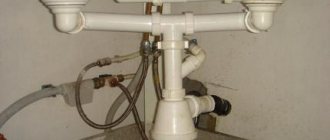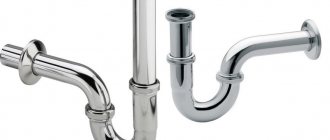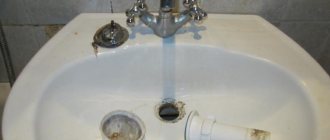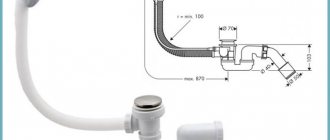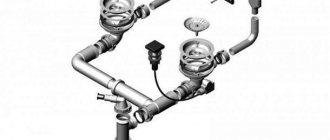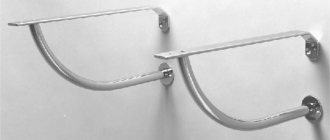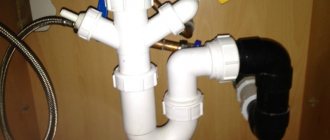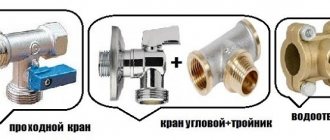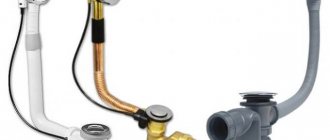With all the variety of drain models for kitchen sinks, the principle of their installation is generally the same; the differences are insignificant. If no mistake was made at the siphon selection stage, then there should be no problems with installation.
In the kitchen, the sink is often actively used, and its drainage system is subject to significant load . An ill-considered choice of a siphon for a kitchen sink will lead to water stagnating in it, the drain will have to be cleaned frequently, and the sewer may become clogged with all the unpleasant consequences.
Therefore, the first stage of successfully installing a sink siphon in the kitchen is the right choice .
Structure
A siphon is a metal or plastic structure that includes a reservoir and several pipes. One connects to the sink drain, the other to the sewer. It is in them that water flows when we wash our faces or wash dishes. Initially, the liquid from the sink enters the siphon, and from it through a curved pipe into the common sewer riser. A metal mesh located at the base of the device, on the sink opening, acts as a fine-mesh filter, protecting the system from blockages.
The curvature of the siphon ensures that a certain volume of liquid is retained, forming a water seal that prevents sewer odors from entering the house.
The purchased siphon kit usually includes a body, inlet and outlet pipes, metal mesh, linings and other consumables. Experts recommend purchasing models equipped with an overflow, which helps avoid flooding.
The main task of drain fittings
The purpose of the overflow drain system is to ensure the drainage of wastewater from the sink into the sewer riser.
But there are several additional tasks performed by different parts of this system:
- Protection of the drainage system from clogging with food waste. The protective mesh located on the neck helps to cope with this task. It is located directly in the sink, and the user can easily remove accumulated dirt without disassembling the siphon.
- Passage of waste water from the sink to the drainage system. This can be easily handled by plastic or metal anti-corrosion pipes, designed in such a way that grease and other waste are removed into the sewer without delay and do not form deposits on the inside of the drain fittings.
It is very important to install the siphon correctly to prevent leaks - Formation of a water seal. This task is performed directly by the body of the product - the siphon. Due to the difference in the height of its bottom and the outlet pipe, a water seal is formed, with the help of which gases accumulating in the sewer do not escape into the living space.
Pipe siphon
Pipe is a popular option for a ceramic bathroom sink. It is not worth installing it in the kitchen, since it is more difficult to clean than other devices. These models are compact in size and attractive in design. The water seal is formed due to the curvature of the pipe. The lower leg of the device is usually removable. It will have to be dismantled to clean it.
The disadvantages of such a siphon include the following points:
- A shallow water seal, due to which the liquid evaporates quite quickly, and if the sink is rarely used, an unpleasant odor may appear in the room.
- The rigid design requires careful sizing: the siphon outlet must be located so that it can be connected to the sewer; installation is only permissible on standard drainage pipes.
USEFUL INFORMATION: How to make forced ventilation in the bathroom
Installation features
Now let's move on to the most important part and figure out how to assemble a siphon for a kitchen sink. Connecting a siphon to a sink is a simple process, but if you do not have experience in such work, it is better to read the step-by-step instructions to do everything correctly. Otherwise, the risk of leaks and unpleasant odors in the drain increases.
To connect a siphon to a kitchen sink, you must first dismantle the old mechanism.
How to change the siphon under the kitchen sink? Take a screwdriver and remove the screw in the center of the drain grate above the container. Remove the siphon and liner to the sewer system. Now you should check the fitting and, if necessary, replace it with a new one. When the structure is removed, wipe the drain hole, remove all dirt and cover the pipe for a while with a damp cloth or a special stopper to prevent the smell from spreading throughout the room. Attention! If after prolonged use of the sink it is difficult to unscrew the nut and screw, disconnect the bottom of the siphon, leaving one adapter, and twist to better separate the elements.
If this process does not help, use special dissolving liquids. Now let's proceed directly to replacing the siphon. We’ll tell you how to install a siphon on a kitchen sink using the example of installing a corrugated model:
- start with the preparatory work. When using a cast iron pipe, you should thoroughly clean it from the inside, get rid of built-up layers and install a new gasket. If there is a plastic pipe in the kitchen, place its end at a height of forty centimeters from the floor and secure a special connector on top;
- Now you can start assembling. When purchasing an already assembled structure, disassemble the model and check if all the elements are present. When assembling by hand, tighten all parts tightly, but do not over-tighten, otherwise the gasket or threads may be damaged. Start by placing a large gasket over the drain hole and screwing on the cap. This will give you two different sized holes on the top side of the siphon. Select a gasket and a coupler nut for the pipe that will connect to the sink. Put on the nut, tighten the gasket - and carefully screw the pipe into the upper siphon hole. Place the nut and cone-shaped gasket on the corrugation, screw it to the siphon. The drainage system is ready;
- the next stage is the installation of the drain structure itself. Place a ring-shaped seal on the pipe. It should be installed with the corrugation facing up. Place the second such ring under the steel grill. Place a pipe under the drain hole in the sink, align it - and attach a steel grate over the sink for protection. Place the connecting screw in it and tighten it;
- Next, start connecting to the sewer riser. Unscrew the outlet part of the pipe, place it in the sewer outlet - and screw it back on. As a rule, the diameter of the sewer pipe exceeds the diameter of the siphon outlet, so a seal should be installed. A ring made of plastic or rubber is installed on the corrugation. Its internal diameter should correspond to the diameter of the outlet pipe, and its external diameter should correspond to the diameter of the outlet pipe;
- The final stage of installing a siphon under a kitchen sink is checking the reliability of the structure. Make sure that it does not leak: fill it with water until a water plug forms - and see if there are any leaks.
If you are using a corrugated elbow, connect it to the drain before attaching it to the socket. And when using a rigid pipe, this procedure can be performed later.
How to assemble a kitchen siphon - watch this useful video:
Bottle
Bottle siphon is the most popular type. Its design evokes associations with a flask or bottle, hence the name. The exhaust pipe can be either rigid or flexible corrugated.
Advantages of bottle devices:
- The siphon design allows you to effortlessly dismantle its most clogged part.
- This model is easy to maintain.
- The bottle drain does not need to be replaced for a long period of time.
- There is always water in the water seal, so the apartment is reliably protected from sewer smell.
- If small things get into the drain, they can be easily removed by unscrewing the flask.
The bottle version has some disadvantages: it accumulates contaminants in the drain container (hair, threads, grease), and is also more prone to leakage than other varieties due to the larger number of connections.
How to choose and buy a siphon for a kitchen sink: prices
You can see prices for some models of sink siphons in the table below:
| Photo | Models | Peculiarities | Average price, rub. |
| Siphon GEBERIT 150.520.21.1 | Material metal. Diameter 52 mm. | 2199 | |
| Siphon MARMORIN EN000008141 | High quality plastic. | 1500 | |
| VIEGA 103927 | Plastic case. | 239 | |
| Sink siphon Material Nicoll C292 | Polypropylene body. TRE gaskets. | 290 | |
| Siphon Wirquin | Material plastic. Water seal 50 mm. | 310 |
Review by Hamson, St. Petersburg: Siphon for kitchen sink Equation - It’s hard in the country without a siphon.
Advantages: price, simplicity and reliability
Disadvantages: none found yet
Most of my friends, especially women, believe that the main function of a siphon installed in a drainage system is to prevent it from clogging with oversized waste...
More details on Otzovik: https://otzovik.com/review_4961989.html
Review by Maua, Kramatorsk: Siphon Orio A-4007 with overflow – Wash the dishes? And with pleasure!
Advantages: functional removable mesh drain; overflow system; volumetric siphon bowl
Disadvantages: the kit does not include a flexible tube connecting the siphon to the sewer
My unexpected happiness began with the purchase of a new kitchen sink. The sink met all the requirements; it was wide, right-handed, with a deep bowl for washing dishes, but the drain hole was of non-standard large sizes. For this wide hole it was necessary to select a siphon with a similar hole. My husband picked it up, for which I will now be grateful to him forever, since washing dishes is now a real pleasure for me. The comparison, of course, is not very good, but still you have to wash dishes every day, so extra comfort in this matter will not hurt at all...
More details on Otzovik: https://otzovik.com/review_2656643.html
Corrugated
This device is easy to install and consists of an outlet and a curved corrugated pipe.
Advantages of using a siphon for a corrugated sink:
- Can be connected to sinks and sewer risers even if their location is non-standard.
- Easy to install and affordable.
- The bend for the water seal is formed by the installer himself.
- Due to the absence of connections, the possibility of leakage is virtually eliminated.
- Regardless of the distance separating the sink and the floor, high-quality drainage will be ensured.
Like bottle drains, corrugated drains have their drawbacks:
- due to the unevenness of the inner surface, deposits of debris and dirt quickly form on it;
- hot water negatively affects the strength of corrugated pipes.
Flat siphon
A type of bottle device. The main difference is the compact size and flat flask. It is used in cases where there is simply no space for a standard product, for example when installing a sink above a washing machine.
Advantages of a flat siphon:
- Due to its compactness, it can be installed in the most difficult to reach places.
- Cleans up just as easily as a regular bottle model.
- Allows rational use of the space under the washbasin, for example for installing a household appliance or cabinet.
USEFUL INFORMATION: Bathroom design in a classic style: examples and photos
Additional functional elements
Siphons installed under the sink may have the following accessories:
- Drain-overflow. If the washbasin is equipped with a second top drain, a siphon equipped with an additional pipe (overflow) is installed under it. This will avoid accidental flooding.
- Bottom valve. A mechanism installed in the drain hole instead of a grate and acting as a plug.
- Additional side fitting for connecting household appliances (washing machine or dishwasher).
- Duplicate branch. It has a special siphon designed for sinks with two bowls. We select a drain for them with the required number of outlets. This is exactly the device shown in the photo below.
Complete set of drain and overflow system
In order to assemble a drain system, you need to know all its components. Here is a list of the main parts of a siphon with overflow:
- Release. Upper part of the system. Attaches directly to the sink and consists of 3 parts: mesh, bolt, base.
- Neck. It has a wide nut with which it is screwed to the outlet. Can be equipped with additional pipes for connecting kitchen appliances.
- Overflow hose. Screwed to the outlet or neck using a plastic nut.
- Attaching the overflow mesh. A metal bolt that is screwed into the side of the sink bowl.
- Siphon body. A bottle into which a siphon neck fits using a cone seal.
Complete set of drain and overflow system
- Outlet pipe. The closing link of the siphon connecting the drain fittings to the sewer system. Attached to the bottle using a wide plastic nut.
- A set of seals and cuffs for assembling the overflow drain system.
Each part is connected to its neighbor only through a rubber seal. Without gaskets and cuffs, leaks form in the system.
Important! Check that the gaskets are installed correctly. Do not allow their integrity to be damaged or jammed.
Using a complete list of component parts and instructions, you can assemble the product yourself.
Possible materials of manufacture
Materials used to create siphons:
- Metal. The products are distinguished by their decorative appeal and increased strength, but over time they can be subject to corrosion and oxidation. They are usually made of brass, less often - of bronze, copper, stainless steel. The most common models are chrome plated. The main disadvantage is the difficulty in selecting the size, because shortening a metal pipe will not be easy.
Chrome-plated products are chosen for wall-hung and countertop sinks. Being visible, they not only do not spoil the design of the washbasin, but also complement it favorably.
- Plastic. Due to their affordable price and good performance, plastic products are in great demand and popularity. They are lightweight, simple in design, and resistant to household chemicals. In the connecting nodes, the plastic siphon is equipped with rubber seals, which increases the service life of the product and its tightness. The product range of many manufacturers includes models with a special antibacterial coating of the internal cavity, which prevents the settling of grease and dirt and reduces the rate of clogging.
Selection rules
How to choose not only a suitable, but also a high-quality siphon? It is important that the sink in the bathroom fulfills its purpose, so it should be equipped in accordance with all the rules.
When choosing a siphon, you should consider important recommendations that will help you purchase a high-quality design:
- When choosing a siphon, you must take into account the type of sink under which this device will be installed. If there is an open space under the sink, then it is better to purchase a product made from a metal base; it looks beautiful and aesthetically pleasing. Plastic siphons look ugly, so they should be used under closed plumbing fixtures;
- Be sure to take into account the size of the area in the bathroom. If the bathroom has a small area, then it is better to purchase products with a corrugated base. Corrugated structures take up little space, they can take on any shape, and can be installed in small spaces. These designs will allow you to place a washing machine next to the sink;
- if a siphon is needed for houses where there is no heating, for country houses, for dachas, then a dry type product is suitable;
- throughput level - must correspond to the number of connected household appliances and the level of water pressure. The greater these indicators are, the higher the throughput of the siphon should be;
- the size of the cross-sectional width of the siphon - the level of throughput depends on this indicator;
- cost - metal products usually cost more than plastic products.
In order for these products to serve for a long time and perform their functions, it is worth choosing them correctly. Therefore, it is necessary to study all types of structures, their features, constituent elements, and purpose. It is important that they can last a long time, but at the same time that they perform their functions and do not cause inconvenience when using them. If you are thinking about which design to purchase, it is better to first consider all their varieties and detailed characteristics.
